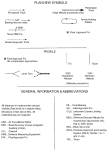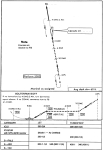
Carrier Operations
Approach
Depart the marshal stack at 250 knots with a 4,000 fpm rate of descent (In NAV master mode, the rate of descent appears on your HUD above the airspeed). When you reach 5,000 feet, slow your rate of descent to 1,200 feet per minute. This is called the “platform”, and you will report it as such to the controller. Continue your descent to 1,200 feet and level off.
At a distance of 10nm to the carrier, dirty up (deploy your flaps, hook, and landing gear). According to the NATOPS, you are to maintain 250 knots, but in Jane’s F-18 the gear cannot be lowered above 240 knots. Slow enough the lower the gear; about 235 knots should do. Engage the ILS system (keystroke “l” and use it to correct any errors in your centerline alignment; you should aim slightly to the right of the ILS centerline. At this point you will be below the glideslope; maintain your altitude.
At a distance of 5nm to the carrier, the final approach controller will contact you with the following message: “[callsign], five miles. ACLS lock on, call your needles.” You will respond “[callsign], fly up (down), fly right (left).” The ACLS is the Automatic Carrier Landing System, and under normal operations will guide your aircraft to a hands-free trap. If you wish to use it at this time, ensure the autopilot is coupled to ACL steering and engage the autopilot system at this time. Your report of the ACLS needle positions exists to cross-check your ACLS system with the carrier’s determination of where your aircraft is relative to the glideslope and centerline. In real life things aren’t always working properly, but in the sim they are, so you will hear the final approach controller say “concur”, confirming that your ACLS system is functioning properly.
Continue level flight at 235 knots until you intercept the glideslope. At this point you should reduce speed and increase your angle of attack so that you are descending along the 3-degree glideslope.
NATOPS CASE III Recovery

